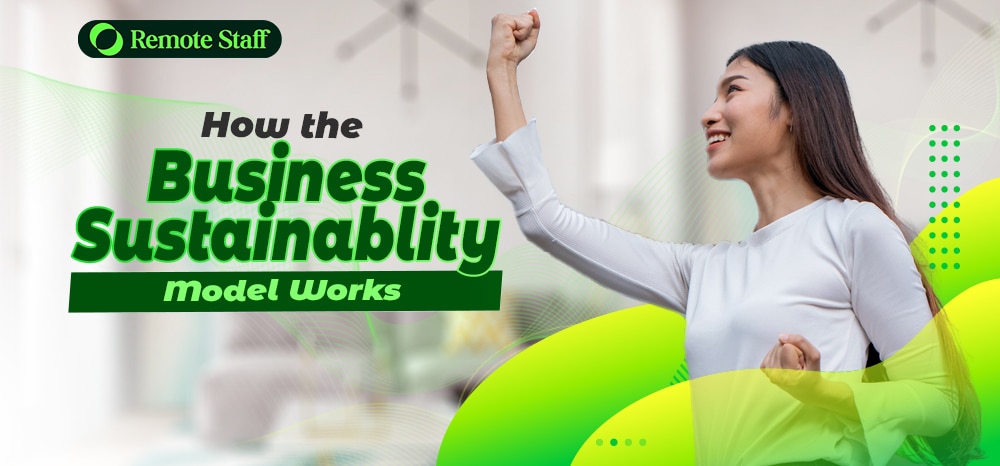A sustainable business model allows companies to operate in an environmentally responsible, socially equitable, and economically viable manner.
Adopting a business sustainability model is also about creating long-term value for your company, society, and the environment as well.
Scroll further to learn more about how a business sustainability model works.
The Core Principles of Business Sustainability

At its core, business sustainability revolves around three fundamental principles:
- Environmental integrity
- Social equity
- Economic viability
Environmental Integrity
Upholding environmental integrity involves taking deliberate actions to recognise and reduce your business’ carbon footprint.
This principle is about going above and beyond to ensure your operations don’t harm the environment.
How to achieve Environmental Integrity?
Sustainable resources
Going for sustainable resources is the first step towards achieving environmental integrity. It involves:
- Evaluating how your business consumes resources, from energy to raw materials.
- Finding ways to minimise waste and maximise efficiency.
- Implementing energy-efficient technologies and practices to reduce consumption.
- Adopting principles to reuse and recycle resources throughout your operations.
- Investing in green infrastructure to lessen your carbon footprint.
Pollution and waste management
Effective pollution and waste management is a key aspect of sustainability. This involves reducing emissions and waste and driving innovation further by repurposing or recycling these whenever possible.
- Implementing stricter controls on industrial emissions to reduce air and water pollution.
- Adopting zero-waste policies in operations to minimise landfill contributions.
- Developing products with recyclable or biodegradable materials
- Investing in advanced waste treatment technologies that convert waste into energy.
Social Equity
This principle underscores the importance of these factors within your business operations:
- Guaranteeing fair wages and working conditions for all employees, regardless of their role.
- Fostering a workplace culture that respects diverse backgrounds, beliefs, and perspectives.
- Upholding the dignity of every individual by providing equal opportunities for growth and development.
- Promoting inclusivity and accessibility in products, services, and employment practices.
With those elements, business practices can support and enhance the well-being of all stakeholders, such as:
- Implementing continuous training and professional development programs to empower employees and encourage their career progress.
- Designing products and services that meet the needs of a diverse customer base.
- Engaging in community development projects and initiatives that support local economies and enhance their quality of life.
- Establishing partnerships with local businesses and suppliers to foster economic growth and sustainability within the communities.
Fair labor practices
Fair labour practices are at the heart of social equity. This means providing employees with:
- Freeing all workplaces from hazards and risks, and complying with health and safety regulations.
- Compensating employees with wages that not only meet legal minimums but also reflect the cost of living and industry standards.
- Offering training programs, mentorship opportunities, and clear pathways for career advancement within the company.
- Promoting work-life balance through flexible working hours, remote work options, and support for personal commitments.
It’s about recognising the value of your workforce and investing in their well-being since happy, satisfied employees tend to be more loyal and productive.
Community involvement and development
Community involvement and development allow businesses to give back to the communities they are part of.
This can range from supporting local initiatives and charities to engaging in projects that contribute to local economic development.
It’s about building strong, mutually beneficial relationships with the community. As your business grows, so does the community around you – and vice versa.
- Sponsoring local events and youth sports teams to foster community spirit and provide recreational opportunities.
- Partnering with local schools and educational institutions to offer internships, scholarships, and educational resources.
- Initiating environmental sustainability projects, such as tree planting or clean-up drives, to enhance the local environment.
- Supporting local small businesses by incorporating their products and services into your business operations.
Economic Viability
Economic viability is at the heart of sustainable business practices —a principle underpinning the idea that businesses can be both profitable and socially or environmentally responsible.
Long-term economic strategies for sustainability
The right long-term economic strategies can guarantee that your business’s growth won’t compromise our planet.
This includes:
- Opting for renewable energy sources to reduce operational costs in the long run.
- Embracing the 4Rs (reduce, reuse, recycle, and remove) to minimise waste.
- Investing in sustainable supply chains to guarantee ethical sourcing and reduce environmental impact.
- Implementing green building practices and energy-efficient technologies in office spaces and manufacturing processes.
Balancing profitability with ethical practices
Balancing profitability with ethical practices demands a measured approach, where you need to measure the social and environmental impact of your decisions.
This also leads to business operations that foster goodwill among consumers and stakeholders.
- Conducting regular ethical audits to ensure business practices align with core values.
- Transparently communicating with stakeholders about business practices, challenges, and achievements in sustainability.
- Engaging in corporate social responsibility (CSR) initiatives that directly benefit social causes and the environment.
- Prioritising long-term environmental and social goals over short-term financial gains to build a sustainable brand.
Quick, Actionable Steps to Implementing the Sustainability Model in Business Operations

The shift towards implementing the sustainability model in business operations marks a critical phase where ideals and action intersect.
It also transforms an abstract concept like sustainability into concrete practices that can drive your business forward.
Assessment and Planning
It all begins with assessment and planning, where businesses take note of their sustainability footprint and develop an improvement plan.
Conducting a sustainability audit
Start with a sustainability audit. This is a comprehensive review of your business operations to identify areas where you can:
- Implement recycling programs and reduce single-use materials to significantly cut down on waste production.
- Streamline processes and upgrade to energy-efficient equipment to enhance operational efficiency.
- Opt for eco-friendly materials and suppliers with sustainable practices.
Getting a clear picture of your impact and identifying opportunities for improvement makes for a more organised sustainability audit.
Setting measurable goals and objectives
Clear, measurable goals are key to tracking your progress, whether it’s for profitability or sustainability.
- Establishing specific targets for reducing carbon emissions within a set timeframe.
- Defining clear benchmarks for waste reduction, including percentages of recycled materials used in production.
- Setting quantifiable objectives for energy savings through the adoption of renewable energy sources and energy-efficient practices.
- Creating milestones to implement sustainable supply chain practices, such as sourcing materials from certified sustainable suppliers.
Sustainable Supply Chain Management
With a plan in place, we can shift to sustainable supply chain management in commerce.
This ensures that your commitment to sustainability is felt throughout every link in your supply chain.
- Adopting procurement policies that prioritise vendors and suppliers who adhere to sustainable practices and ethical labour standards.
- Implementing traceability systems to monitor the environmental and social impact of products throughout the supply chain.
- Encouraging suppliers to adopt greener practices by providing incentives for sustainability improvements and innovations.
- Conducting regular audits of supply chain partners to comply with sustainability criteria and continuous improvement.
Criteria for selecting suppliers
When selecting suppliers, consider their commitment to sustainability, such as using renewable resources or engaging in fair labour practices.
- Certifications and Awards. Evaluating suppliers’ certifications and awards for environmental and social sustainability.
- Supply Chain Transparency. Verifying supply chain practices for ingredient or material transparency.
- Community Involvement. Considering the supplier’s involvement in community and social development projects as a measure of their commitment to social equity.
- Innovation and Improvement. Reviewing the innovation and continuous improvement efforts suppliers make towards enhancing sustainability.
Reducing your carbon footprint and enhancing efficiency
This can be achieved through strategies like:
- Implementing route optimisation and fleet management solutions to decrease fuel consumption and emissions to lower their carbon footprint.
- Choosing suppliers located closer to the point of use to minimise transportation distances, thereby reducing logistics costs and environmental impact.
Product Design and Innovation
Product design and innovation are critical for creating sustainable products that meet customer needs without compromising future generations to meet theirs.
This involves considering the environmental impact of your products from design to disposal.
- Selecting materials that are recyclable, biodegradable, or derived from sustainable sources.
- Designing manufacturing processes that consume less energy, reducing the carbon footprint of the production process.
- Creating products that are built to last, reducing the need for frequent replacements and minimising waste.
- Incorporating designs that allow for easy disassembly and recycling so products can be responsibly disposed of or repurposed.
Designing for sustainability
Designing for sustainability means considering the entire lifecycle of your products, from sourcing materials to end-of-life disposal.
Creating products that are durable, efficient, and recyclable minimises your overall footprint.
- Choosing materials that are sustainably harvested or recycled to reduce environmental impact from the start.
- Making sure products are energy-efficient, reducing the consumption of resources during their lifespan.
- Creating products with interchangeable parts for easy repair or upgrade, extending their usability.
- Designing products so that they can be easily dismantled and recycled so materials can be reused at the end of the product’s life.
Life cycle assessment of products
Assessing the life cycle of your products further aids the process and also helps identify opportunities for improvement that lead to innovation in product design and development.
- Evaluating the environmental impact of sourcing raw materials, to reduce the carbon footprint from the very beginning of the product life cycle.
- Analysing energy consumption and waste production during manufacturing to identify areas for efficiency improvements and waste reduction.
- Assessing how consumers use the products and their energy or resource needs, with a focus on enhancing product efficiency and reducing operational impacts.
- Examining the disposal, recycling, or repurposing options for products at the end of their life cycle to ensure minimal environmental impact.
Case Studies: Success Stories of Sustainable Business Models in Australia

The journey towards sustainability comes with success stories that inspire and instruct.
These case studies highlight the practical benefits of integrating sustainable practices into business operations for a positive impact across various industries.
Small and Medium Enterprises (SMEs)
Small and medium enterprises are often at the forefront of innovating for sustainability.
Their size allows for quick adaptation and implementation of green practices, making them pioneers in the sustainability space.
Examples of successful sustainable practices in SMEs
For instance, examples of successful sustainable practices in SMEs include local retailers like:
- Who Gives A Crap. An Australian company that produces environmentally friendly toilet paper
- KeepCup. They make reusable coffee cups designed to reduce waste.
These SMEs have not only minimised their environmental footprint, but have also built strong brand identities around their commitment to sustainability.
Large Corporations
On the other end of the spectrum, large corporations wield significant influence in promoting sustainability on a global scale.
Their efforts can lead to substantial environmental benefits and set industry-wide standards for sustainable practices.
How multinational companies are leading the sustainability charge
Companies such as Telstra and the Woolworths Group are often cited for their leadership in sustainability.
Telstra aims for carbon neutrality through renewable energy and efficiency. Woolworths strives to reduce waste and improve sustainability in its operations.
These efforts highlight how major companies can drive environmental and social progress while setting global standards for sustainable business practices.
Future Directions for Sustainable Business Models

Sustainable business models are moving towards a future where environmental and social responsibility are crucial.
This shift is propelled by both innovation and a growing consensus on the urgent need for action addressing global challenges.
Trends and Predictions
Emerging sustainability trends are setting the stage for transformative business practices over the next decade.
These shifts can encourage businesses to become more eco-friendly and socially responsible.
Emerging trends in sustainability
Emerging trends in sustainability are setting the stage for renewable energy and green tech to go mainstream.
They also lead to new opportunities for businesses to reduce their environmental impact for efficiency and cost savings.
Predictions for the next decade
Predictions for the next decade suggest that sustainability will become a critical advantage.
Businesses that fail to adapt may find themselves at a disadvantage, as consumers, investors, and regulators demand:
- More transparency
- Accountability
- Genuine commitment to sustainable practices
The Role of Leadership and Culture
Leadership and culture play a major role in promoting sustainability among businesses.
Leaders need to inspire and cultivate workplace practices that prioritise sustainability as fundamental to the organization’s identity and operations.
Building a culture of sustainability
Building a culture of sustainability within an organization is essential for the successful implementation of sustainable business models.
This culture starts with leadership that embodies a transformation in every aspect of their structure.
Leadership in sustainable business practices
Sustainable business practices involve inspiring an entire organisation towards shared goals such as:
- Setting ambitious targets
- Fostering innovation
- Applying the principles of sustainability
FAQ’s and Conclusion

Here are some of the frequently asked questions (FAQs) regarding business sustainability models:
What Are the First Steps Towards Implementing a Sustainable Business Model?
The first step is conducting a sustainability audit to assess your current environmental impact, social responsibility practices, and economic viability.
This involves reviewing operations, supply chains, and product life cycles to identify areas for improvement.
Following the audit, setting clear, measurable sustainability goals, and integrating these objectives into your business strategy can drive change.
How Can Small Businesses Afford to Implement Sustainable Practices?
Sustainability can seem financially draining, especially for small businesses. However, many sustainable practices, such as reducing waste and using sustainable materials, can lead to cost savings over time.
Additionally, small businesses can explore local government grants, incentives for renewable energy investments, and partnerships to share the costs and benefits of sustainability initiatives.
How Do You Measure the Success of Sustainable Business Practices?
Success can be measured through a variety of metrics, depending on the specific goals set by the business. These can include reductions in energy consumption, waste, and greenhouse gas emissions.
Regularly reviewing these metrics and adjusting strategies as needed is essential for ongoing improvement and sustainability.
The journey towards a more sustainable future presents both a challenge and an opportunity. Embracing sustainability is a strategic move that can drive innovation, enhance brand reputation, and secure long-term profitability.
The path forward requires a commitment to understanding emerging trends and fostering leadership towards sustainability in every business operation.
Take the next step towards a sustainable future for your business. Connect with Remote Staff today and discover how remote staffing solutions can support your sustainability goals.
Call us today or request a call back now!
Darren Aragon is a multifaceted writer with a background in Information Technology, beginning his career in research at Pen Qatar and transitioning through customer service to a significant role at Absolute Service, Inc. His journey into freelance writing in 2021 has seen him excel across various niches, showcasing his adaptability and deep understanding of audience engagement.




















